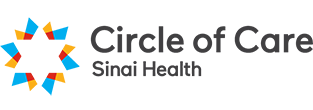Routine Practices
Routine practices are designed to reduce the risk of spreading infectious microorganisms. Routine practices are the minimum practices that should be used with all clients, patients, or residents. These methods protect ourselves and others when there is potential to come in contact with blood or body fluids from others.
The routine practices PSWs and Homemakers at Circle of Care must follow include:
- Frequent and proper hand hygiene
- Universal masking: wearing a mask during all client interactions
- Monitoring and observing clients for symptoms
Clean technique
The clean technique (also called medical asepsis) refers to procedures or methods used to reduce and prevent the spread of microorganisms. The clean technique includes:
- Hand hygiene
- Cleaning the environment
- Wearing the appropriate PPE
- Disinfecting equipment and surfaces/ Maintaining a clean environment or work area
Hand Hygiene
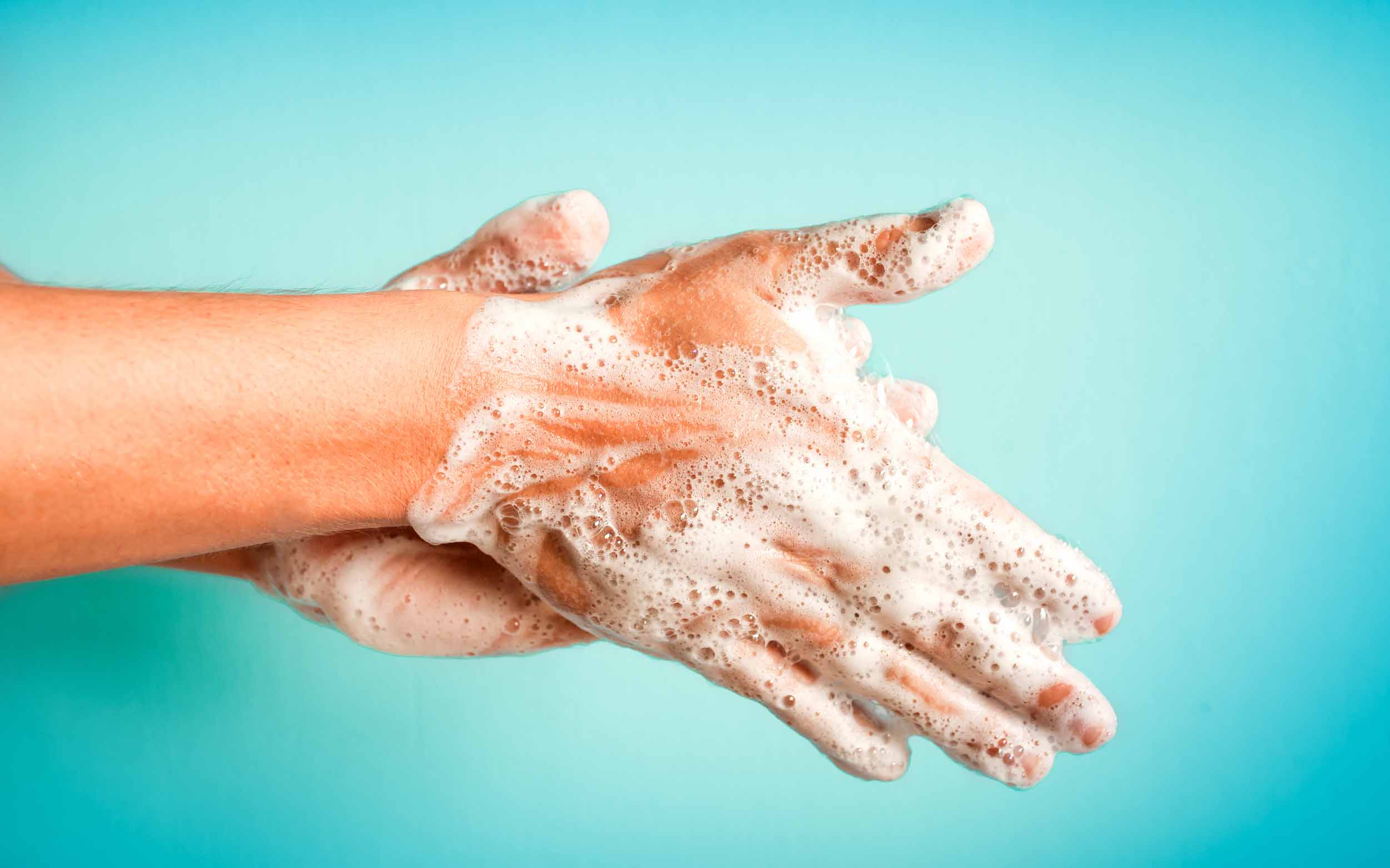
Hand hygiene is the most basic and important technique to prevent the transmission of infections. This is because contaminated hands are one of the primary causes of cross infection. Hand hygiene includes handwashing with soap and water or using alcohol-based hand rub (ABHR). Hand hygiene removes visible soiling as well as removes, kills, or destroys transferable microorganisms.
The 4 moments of hand hygiene are very important for infection prevention and control in home healthcare:
- Before entering a client’s home and/or contact with the client/client’s immediate care environment
- Before preforming a procedure
- After performing a procedure or if there is potential body fluid exposure risk
- After contact with client’s care environment and before exiting client’s home
Certain factors reduce how effectively hand hygiene can remove transferable microorganisms. Prior to performing hand hygiene, it is important to cover any open cuts and remove jewelry. If you have long nails, this can make it harder to clean beneath your nails.
Handwashing with soap and water
Handwashing with soap and water physically removes microorganisms from the hands and using friction. If a client has Clostridium Difficile (C.Diff), you must wash your hand with soap and water because C.Diff spores cannot be eliminated with the use of hand sanitizer.
Steps for Handwashing
- Keep your hands and uniform away from the sink surface.
- Turn on the faucet to regulate the flow and temperature of the water.
- Avoid splashing the water against your uniform.
- Ensure that the temperature of the water is warm.
- Wet your hands and wrists thoroughly under the running water. Keep your hands and forearms lower than your elbows as you wash your hands.
- Apply a small amount of soap and thoroughly lather your hands.
- Lather your hands, using friction for at least 15-20 seconds.
- Interlace your fingers and rub your palms and the back of your hands with circular motions at least 5 times
- Keep your fingernails down so that any microorganisms flow downwards.
- Rub the knuckles of one hands into the palm of the other.
- Repeat with the other hand.
- Rub your thumb on one hand with the palm of the other hand.
- Repeat with the other hand.
- Work the fingers on one hand into the palm of the other.
- Massage soap onto and around your nails.
- Repeat with the other hand.
- Rinse your hands and wrists thoroughly. As you do this, ensure you keep your hands down and elbows up.
- Dry your hands from the fingers to your wrists and forearms with a paper towel.
- Discard the paper towel.
- Turn off the faucet with a clean, dry paper towel. Avoid touching the handles with your clean hands.
Steps for Hand Rubbing
Alcohol-based hand rub (hand sanitizer) is the preferred method of hand hygiene when hands are not visibly dirty. It is also appropriate to use hand sanitizer instead of handwashing if you have not come into contact with any clients with C.Diff. The sanitizer must have an alcohol concentration of 70% or higher in order to be effective.
- Apply an adequate amount of the hand sanitizer to the palm of one hand. Usually you will need 2-3 pumps of product.
- Rub your hands together and cover all the surfaces of your hands and fingers with the sanitizer.
- Rub your palms together.
- Rub the back of your hand with the palm of the other hand. Repeat for the other side.
- Rub between your fingers.
- Press and rub your fingertips of each hand into the palm of the opposite hand.
- Rub your thumbs in a circle using the palm of the opposite hand.
- Rub your hands until the sanitizer is dry.
- This whole process should take around 20 seconds.
- Hands should be fully dry before you put on gloves.
Note: For hands that are dry or chapped, apply a small amount of lotion or barrier cream.
Ways for Germs to Spread
Pathogens (germs) can travel and infect an individual in 4 common ways. These are called modes of transmission:
- Contact
- Direct: contact from person to person
- Indirect contact: contact between a person and contaminated objects
- Droplet transmission
- Infectious droplets propelled through the air from coughing, sneezing or talking
- Airborne transmission
- Small particles or droplets (5mm or less in size) in the air containing infectious agents
- The particles remain suspended in the air or travel with the air currents and are inhaled
- Common object
- Contaminated items such as food, water, medications, medical devices and equipment
Additional Precautions
Additional Precautions may be required at times when routine practices are not enough to reduce or prevent the spread of infectious microorganisms. The type of additional precaution required is based on the way the infection is transmitted.
Additional Precautions are always used in addition to routine practices.
Additional precautions are:
- Used to contain pathogens in one area.
- Used with clients who have highly transmissible pathogens.
- Used in addition to routine practices.
There are 3 categories of additional precautions used and they depend on the mode of transmission of the pathogen that the client is infected with.
- Contact precautions
- Droplet precautions
- Airborne precautions
| Type of Additional Precaution | PPE Required |
|---|---|
| Contact Precautions
Contact precautions should be used when caring for clients with known or suspected infections caused by direct or indirect contact Examples: MRSA, C.Diff, major wound infections, uncontrolled secretions, possible contact with bodily fluids, gastrointestinal, skin, or respiratory infections, norovirus, etc. |
|
| Droplet Precautions
Droplet precautions must be used in clients with known or suspected infections caused by microbes transmitted through droplets produced by coughing, sneezing, or talking Examples: COVID-19, symptoms of coughing and sneezing, rubella, influenza, pertussis, mumps, and diphtheria, pneumonia |
|
| Airborne Precautions
Airborne precautions should be used in addition to routine practices for clients with known or suspected infections caused by microbes transmitted by airborne droplets. Examples: measles, chickenpox (varicella), shingles, tuberculosis (TB), anthrax, and meningitis |
|
Personal Protective Equipment
Personal protective equipment (PPE) is separated into 2 categories: client management PPE and household management PPE. Client management PPE is used to prevent the transmission of infectious agents from client-to-staff, client-to-client, staff-to-client, and staff-to-staff. Household management PPE helps protect workers against tears, cuts, and the chemicals found in cleaning solutions.
It is important for PSWs and Homemakers to wear the required PPE based on the task they are performing. Please make sure you are aware of our current PPE protocols around mandatory PPE.
Client Management PPE
Isolation Gown
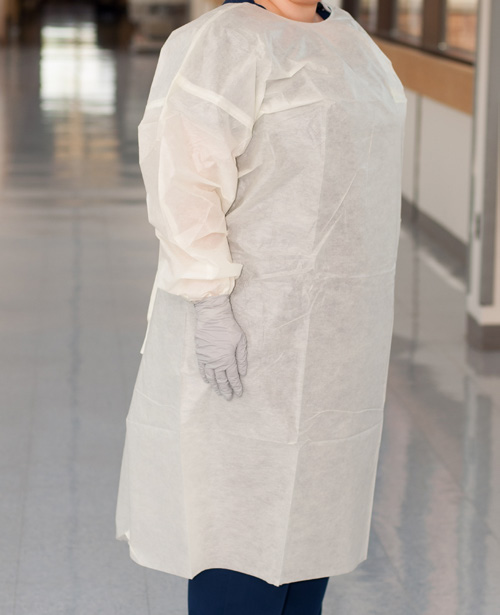
Isolation Gown:
- Isolation gowns are disposable with long sleeves and tight fitting cuffs.
- Do not reuse isolation gowns.
- Isolation gowns should be used in addition to gloves when caring for clients on contact precautions.
- Isolation gowns:
- Prevent the contamination of uniforms or clothing.
- Protect the worker from contact with blood or other bodily fluids.
- Protect the worker from microorganisms in the environment, on equipment, or from an infected client.
Nitrile Gloves
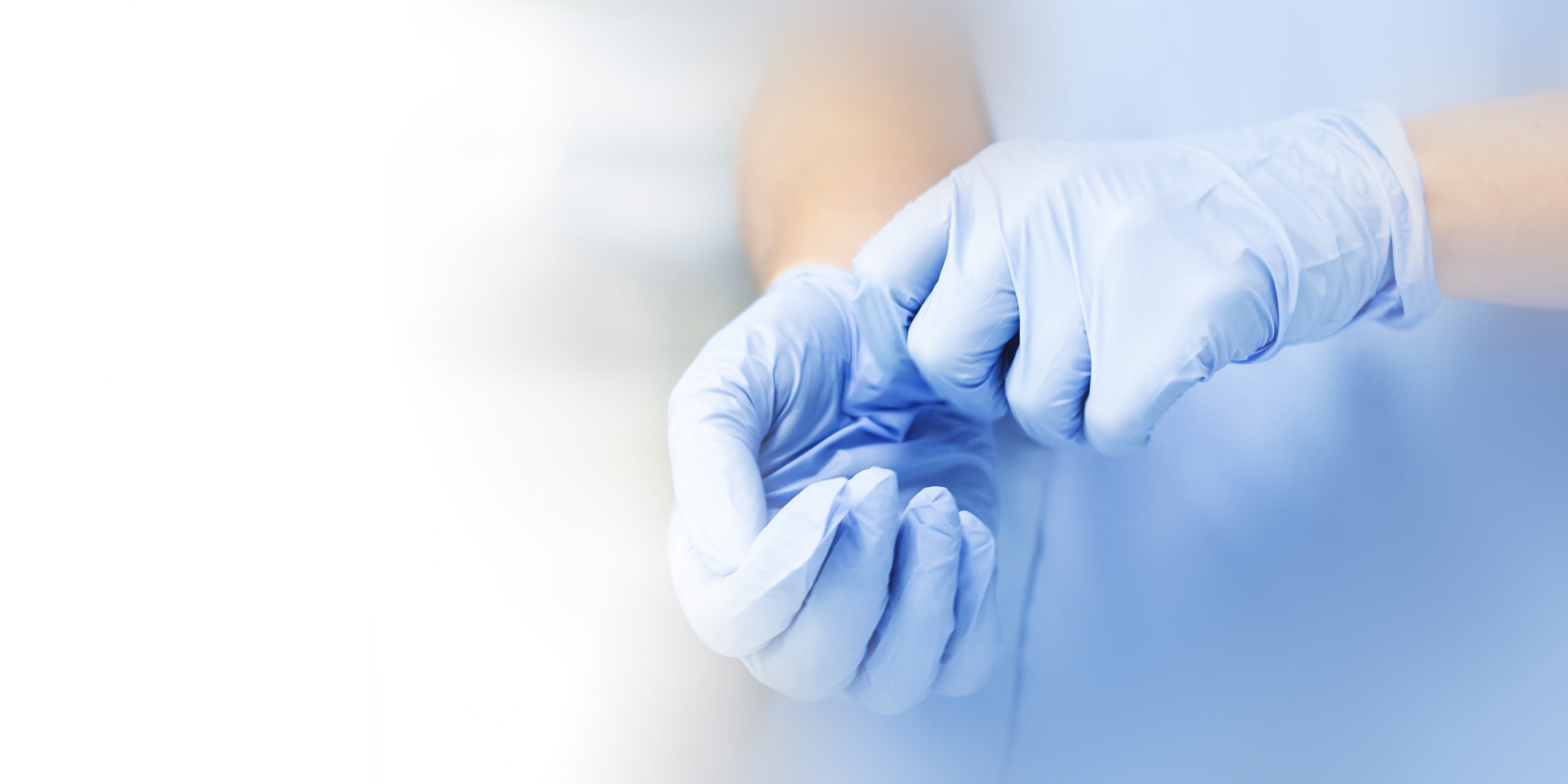
Nitrile Gloves
- Ensure that you are using the correct size of nitrile gloves.
- Nitrile gloves are disposable, which means that these gloves are single-use and must be removed and discarded after each task.
- Do not wash or re-use nitrile gloves.
- The use of disposable nitrile gloves is becoming increasingly common in healthcare settings, as many patients receiving care have latex allergies.
- Nitrile gloves are latex-free, more durable, resistant to chemicals, and puncture-resistant.
- Nitrile gloves should be used when providing personal care to clients.
- Gloves must be worn when your hands will be in contact with mucous membranes, non-intact skin, body fluids, secretions, excretions, or contaminated equipment and surfaces.
- Remember to change your gloves if you are moving from a contaminated body area to a clean body area within the same client.
- Always perform hand hygiene before putting on gloves and after removing them.
Masks
- Protect the nose and mouth from splashes of blood, body fluids, secretions, or excretions.
- There are a variety of different types of masks available.
- The masks that staff are expected to use are:
- Procedure Masks
- N95 Respirators
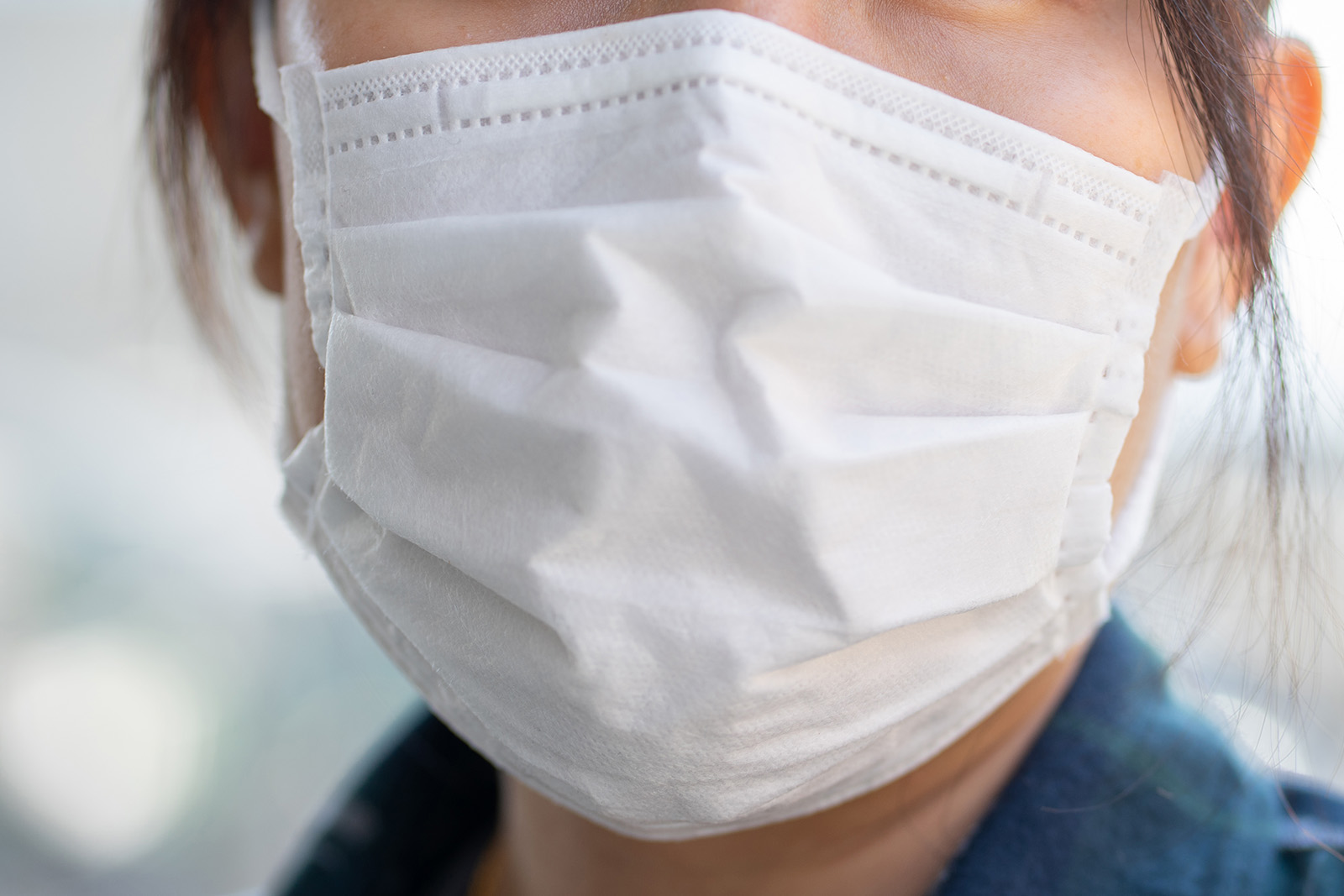
Procedure Masks
- Procedure masks are disposable and help protect individuals from infectious droplets.
- Ensure that the mask is intact and has no defects, rips, or tears.
- Wear a procedure mask within 2 meters of a coughing client and clients placed on droplet precautions.
- The mask should securely cover the nose and mouth.
- Change your mask if it becomes wet.
- Do not touch the mask while wearing it.
- Remove the mask correctly after completing the task and discard it appropriately.
- Perform hand hygiene after removing the mask.
- Do not reuse the mask or fold it and put it in your pocket for later use.
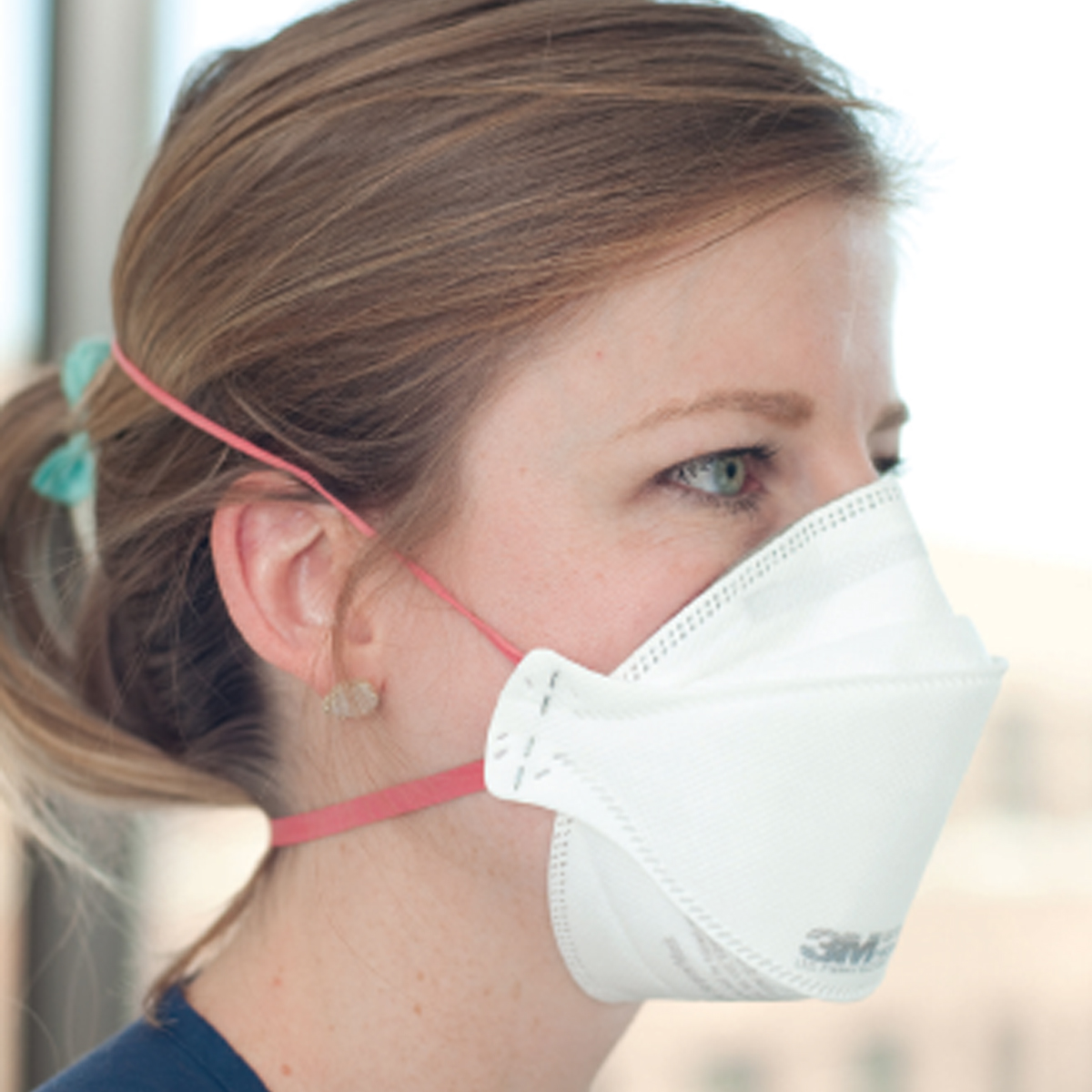
N95 Respirators
- N95 respirators provide more protection than a procedure mask by blocking at least 95 percent of very small (0.3 microns) particles.
- N95 respirators must be fit-tested to ensure maximum protection.
- The mask should fit the face tightly with no gaping.
- Ensure that the mask is intact and has no defects, rips, or tears.
- N95 masks are used with clients on airborne precautions.
Protective Eyewear/Face Shield
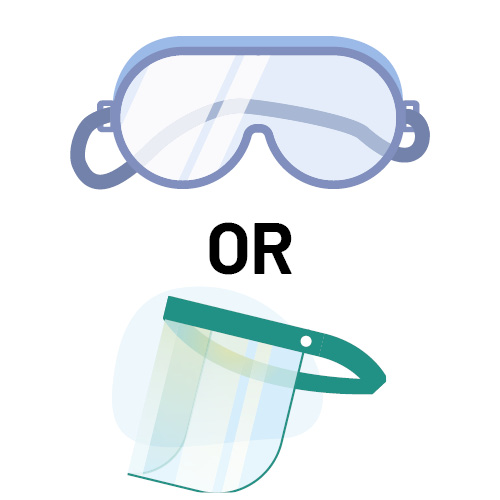
Protective Eyewear/ Face Shield
- Protect eyes from splashes of blood, body fluids, secretions or excretions.
- Eye protection is available in plastic glasses, goggles, face shields, and visors.
- Face shields are disposable and goggles are reusable but must be sanitized appropriately after a client interaction.
Household Management PPE
Rubber Cleaning Gloves
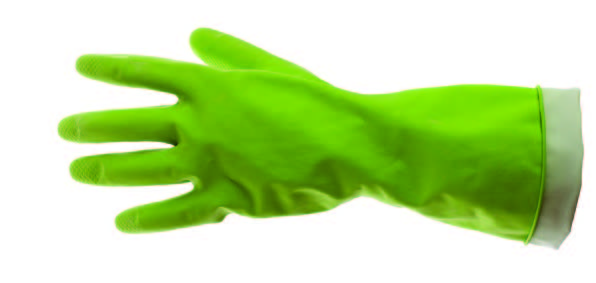
Rubber cleaning gloves
- Rubber cleaning gloves protect PSWs’ and Homemakers’ hands against tears, cuts, and the chemicals found in cleaning solutions.
- Rubber cleaning gloves are thick and rigid, which makes them appropriate for long-term use.
- Rubber gloves should be used when performing light housekeeping in a client’s home.
- Do not clean the kitchen with the same pair of gloves you use to clean the rest of the client’s home.
- Use a separate pair for the kitchen.
- Remember to clean the home from clean to dirty. This means you should clean the bathroom last.
- Rubber cleaning gloves are reusable and must be cleaned properly using soap and water before they are used again at another client’s home.
- You can order multiple pairs from Circle of Care to use between clients.
- At the end of your shift, you should sanitize the rubber gloves. It is recommended to use vinegar and baking soda.
- The video below demonstrates how to properly sanitize rubber cleaning gloves:
Polymer Gloves
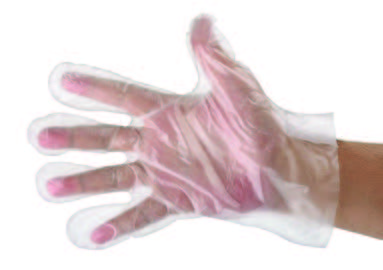
Polymer Gloves
- Polymer gloves are safe for food contact and handling.
- PSWs and Homemakers should use polymer gloves when doing meal preparation in a client’s home.
- Polymer gloves have a looser fit, which makes them easy to put on and take off.
- These gloves are thin and lightweight, which make them more likely to tear. However, polymer gloves are cost-effective and appropriate to use for light meal preparation in the community.
- Polymer gloves are disposable and are intended for short-term use.
Shoe Covers
Shoe Covers
- Shoe covers are disposable and they slip on snugly over shoes to prevent chemicals and other hazardous materials from coming into contact with PSWs’ and Homemakers’ shoes.
- Shoe covers are easy to put on and take off.
- The elastic bands which go around the ankles help keep the shoe covers secure and prevent slipping.
- Shoe covers help reduce contamination and help keep shoes clean.
Donning PPE
Before Donning PPE make sure you have done the following:
- Make sure long hair is tied back and off the shoulders.
- Any headwear (e.g. hijab, turban, kippah, etc.) should be secured and excess material should be tucked into your uniform.
- Remove rings, bracelets, pendants, and watches.
- Ensure that nails are short.
Step 1
Perform hand hygiene.
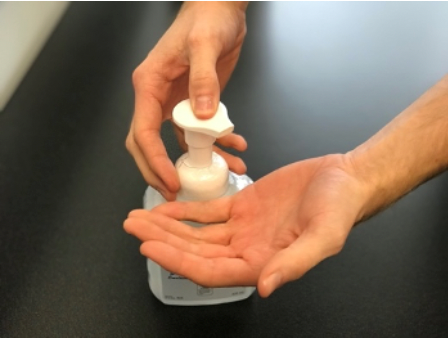
Step 2
Put on the gown. When putting on the gown, make sure that it does not touch the floor.
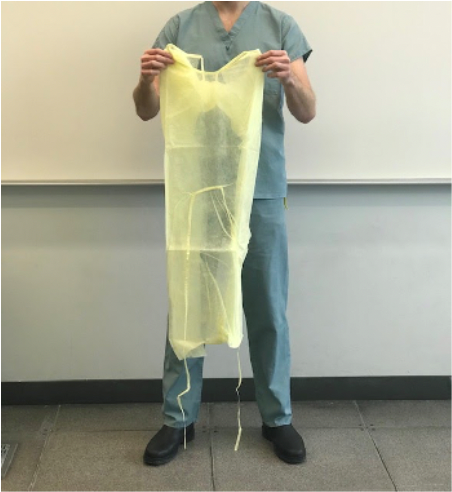
Step 3
Securely tie the neck and waist ties. Make sure your back is covered by the gown.
.
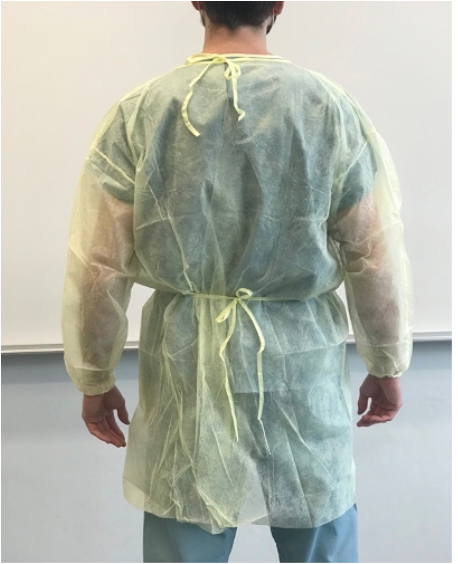
Step 4
Pull sleeves down to wrists.
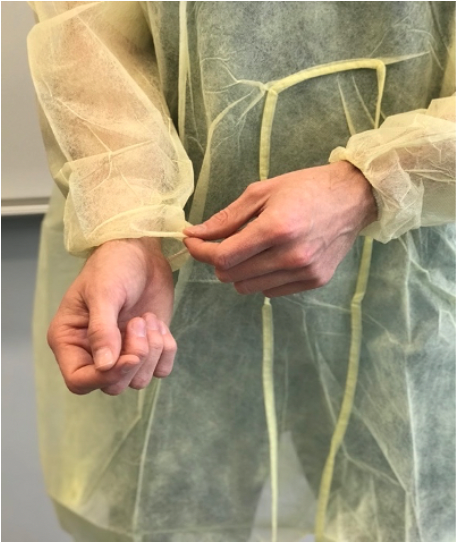
Step 5
Put on a mask. Secure ties, loops, or straps around head or ears.
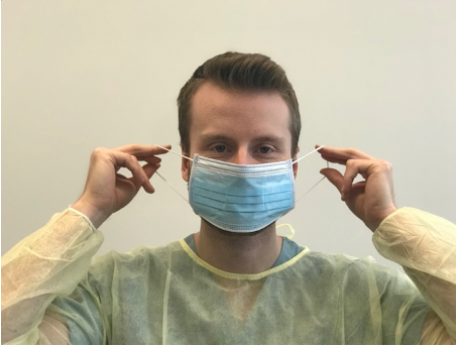
Step 6
Press the metal band around your nose.
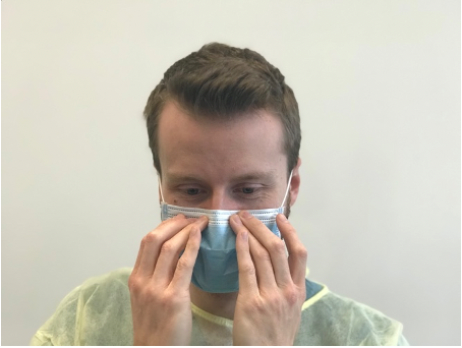
Step 7
Pull the mask over your chin.
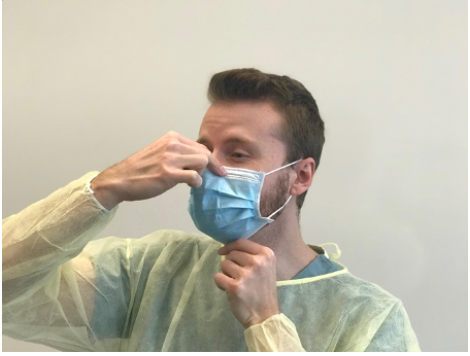
Step 8 (Goggles)
Put on goggles. Adjust the fit of the goggles. Goggles can be worn over prescription glasses.
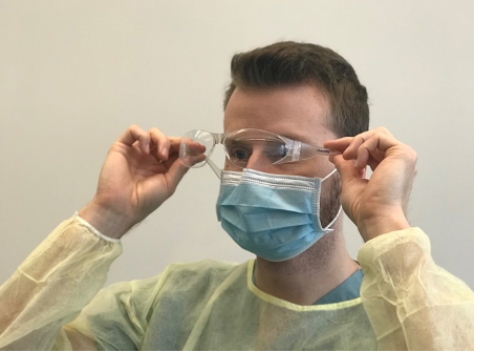
Step 8 (Face Shield)
Put on face shield. The face shield should fit over the brows.
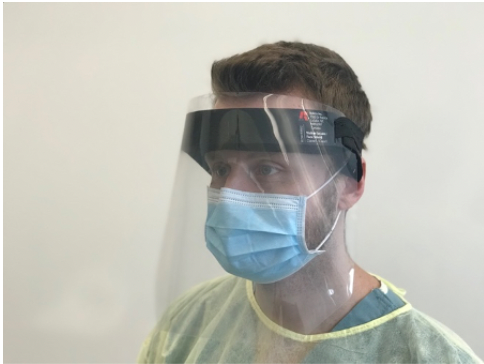
Step 9
Put on your gloves. Visually inspect the gloves for any holes or rips. Gloves must go over the cuff of the gown.
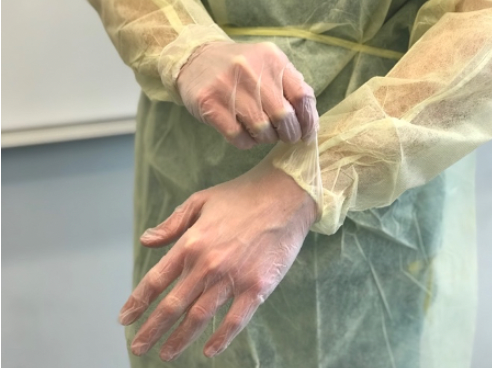
You are now ready to provide care.
Doffing PPE
Step 1
Remove gloves using the glove-to-glove and skin-to-skin technique. Grasp the outer edge of the glove on the inside of the wrist, taking care not to touch skin. Peel the glove off completely by rolling the glove inside out, and hold onto the removed glove in the palm of the remaining gloved hand.
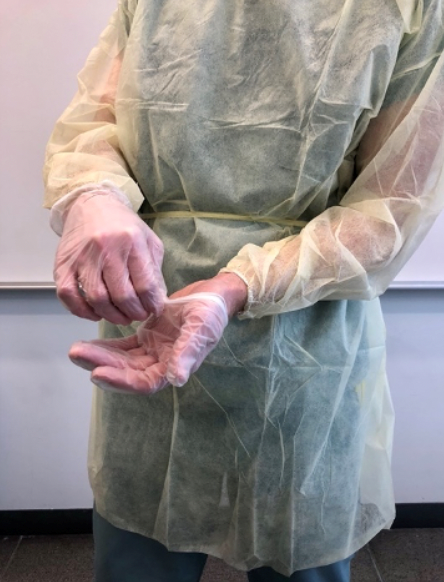
Step 2
Insert 2 fingers of the ungloved hand under the cuff on the inside of the wrist of the gloved hand. Pull of the second glove by turning it inside out.
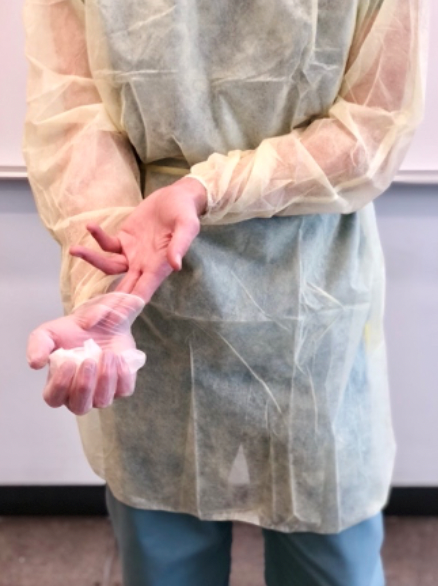
Step 3
Throw out the gloves.
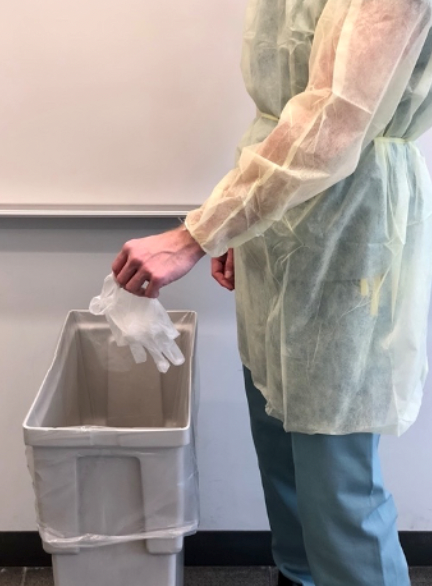
Step 4
Perform hand hygiene.

Step 5
Remove the gown and ensure that you do not contaminate your clothing. Untie the waist, then untie at the neck.
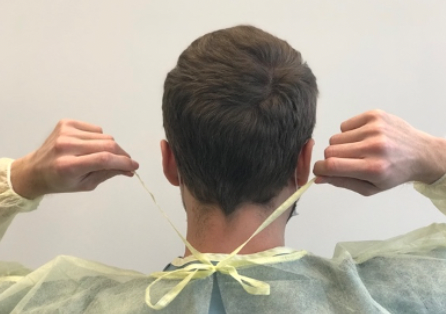
Step 6
From the neck ties, pull the gown forward and turn the gown inward, rolling it into a ball.
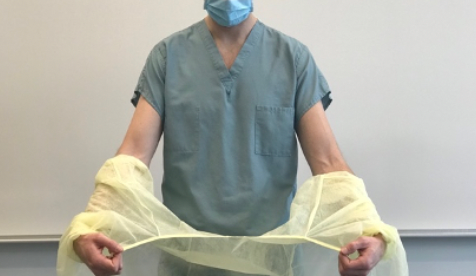
Step 7
Throw out the gown.
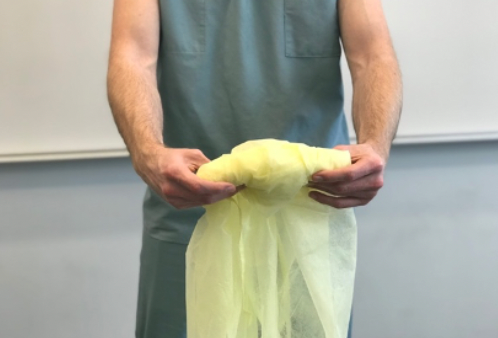
Step 8
Perform hand hygiene.

Step 9
Remove eye protection or the face shield. Use the arms of the goggles or the headband on the face shield when removing. Dispose the face shield or sanitize goggles.
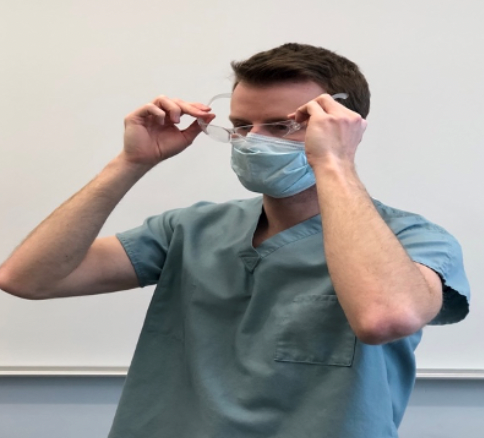
Step 10
Perform hand hygiene.

Step 11
Remove mask using ear loops.
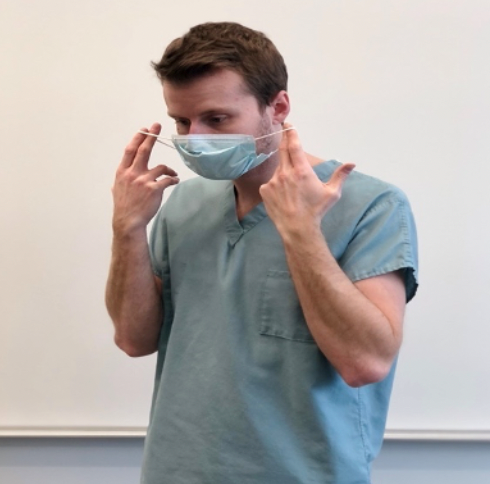
Step 12
Throw out the mask.
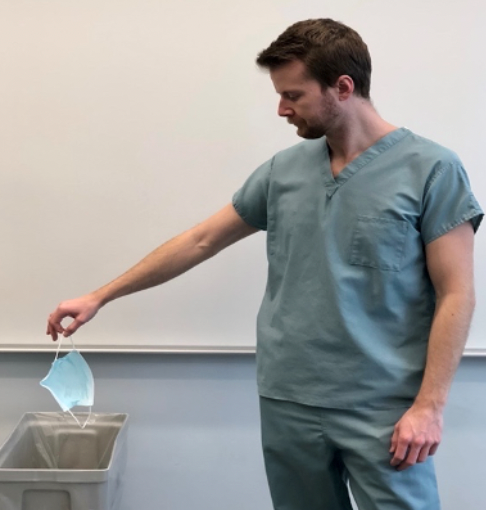
Step 13
Perform hand hygiene.

